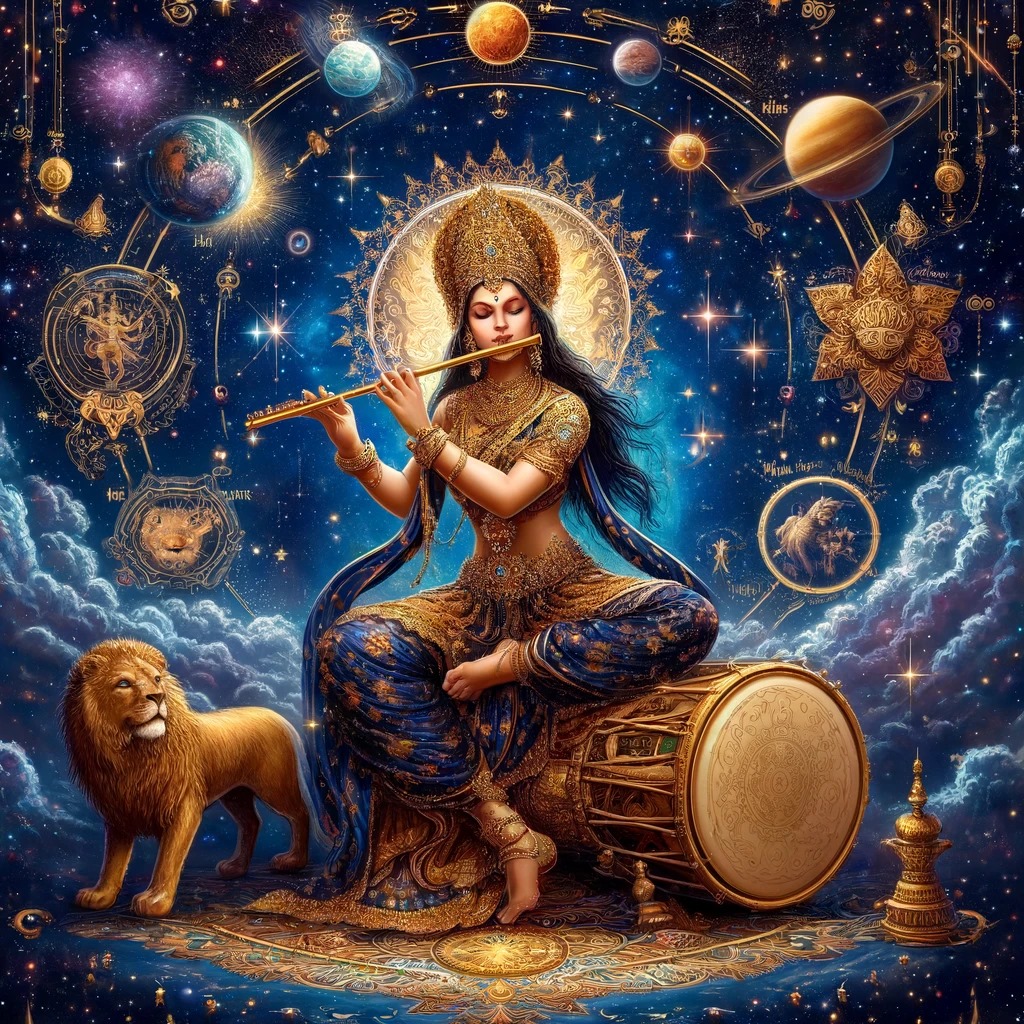5 Powerful Insights About Dhanishta Nakshatra: The Star of Harmony and Abundance
 May 3, 2024
May 3, 2024 Table of Contents
Introduction
Dhanishta Nakshatra, spanning from 26°40′ Capricorn to 6°40′ Aquarius, embodies the rhythmic cadence of the cosmos. Ruled by Mars and symbolized by musical instruments like the drum and flute, this Nakshatra harmonizes the attributes of persistence and peace. The deity associated with Dhanishta is the Ashtavasus, the eight celestial entities representing cosmic principles and prosperity, making this Nakshatra a beacon of abundance and divine order.
Fundamental Characteristics
- Zodiac Range: 26°40′ Capricorn – 6°40′ Aquarius
- Ruling Planet: Mars, influencing energy, courage, and initiative.
- Deity: Ashtavasus, representing elemental cosmic functions.
- Symbol: Drum & Flute, signifying rhythm, music, and celestial harmony.
- Gana: Rakshasa (Demon), indicating formidable power and transformative capabilities.
- Quality: Chara (Moveable), denoting adaptability and dynamic energy.
- Caste: Farmer/Servant, reflecting the nurturing and supportive roles.
- Animal Symbol: Female Lion, known for its majestic and protective nature.
- Bird: Peacock, symbolizing beauty and vibrancy.
- Tree: Indian Mesquite, associated with resilience and healing.
- Sounds: Gaa, Gee, Goo, Gay, resonating with energies that influence creativity and growth.
- Yoga Tara (Fixed Stars): Positioned at 23 degrees, marking significant celestial alignments.
- Padas (Quarters):
- Pada 1: Leo (Fire)
- Pada 2: Virgo (Earth)
- Pada 3: Libra (Air)
- Pada 4: Scorpio (Water)
Each pada enriches Dhanishta with distinctive energies that contribute to its multifaceted nature.

Mythological Background
The Ashtavasus, deities of Dhanishta, encompass a broad spectrum of cosmic and elemental energies, from water and fire to the dawn and the celestial poles. These deities are revered for their ability to bring forth prosperity and fulfill earthly desires. The legend of Bheeshma, one of the Ashtavasus reincarnated as a mighty warrior who could choose the time of his death, highlights the themes of duty, sacrifice, and moral integrity associated with this Nakshatra.
Adding to the mythological richness, the story of the Ashtavasus involves a complex narrative of devotion, error, and redemption. The Ashtavasus, initially divine beings, were cursed to be born on Earth due to one transgression involving the theft of a revered sage’s cow, showcasing the consequences of moral lapses even for celestial beings. This curse brought them into the world of mortals where they were destined to return only after enduring significant trials, demonstrating the cyclic nature of karma and redemption in Hindu mythology.
Their earthly saga continues to unfold lessons on the importance of integrity and the impact of our actions on our spiritual journey. The tales of these celestial beings serve not only as entertaining stories but also as deep moral allegories from which devotees can glean significant life lessons. In particular, Bheeshma’s unparalleled vow of celibacy and his unwavering commitment to his principles, despite numerous trials and tribulations, embody the ultimate sacrifice for familial duty and honor, presenting a powerful example of living one’s values in the face of adversity.
Moreover, the incorporation of these myths into the annual cycle of festivals and rituals, particularly in the celebration of Onam in Kerala, which commemorates King Mahabali’s annual visit from the netherworld, integrates the teachings of Dhanishta Nakshatra into the cultural and spiritual fabric of daily life. Through these stories, the Nakshatra’s influence extends beyond the personal and astrological realms into the collective consciousness of societies, thereby illustrating the pervasive and enduring nature of these ancient narratives.
In this way, the mythological backdrop of Dhanishta Nakshatra not only enriches the understanding of its astrological impact but also enhances the cultural heritage of those who look to the stars for guidance and inspiration.
Influence on Personality and Life
Individuals born under Dhanishta Nakshatra often exhibit traits of leadership, charisma, and a profound connection to nature and the arts. They are known for their ability to create harmony in chaotic situations and often excel in fields that require orchestration of complex systems, such as music, event planning, or leadership roles that demand strategic planning and implementation.
Spiritual and Esoteric Significance
Dhanishta’s connection to musical symbols points to the spiritual significance of vibration and sound in the universe. This Nakshatra teaches the importance of inner harmony and the alignment of personal vibrations with cosmic rhythms, encouraging individuals to find their unique sound in the symphony of life.
Exploring Nakshatras with PocketPandit
For those interested in the rich symbolism and influences of Nakshatras like Dhanishta, PocketPandit offers in-depth insights and practical guidance. Utilizing the advanced technology of PocketSoft, users can access detailed astrological analyses, enabling a deeper understanding of their personal astrological blueprint through services available at pocketpandit.com/ask or via the mobile app.
Conclusion
Dhanishta Nakshatra stands as a powerful reminder of the interconnectedness of all things through the universal language of music and rhythm. Its energies foster resilience, creativity, and the ability to prosper through harmony and balance. By embracing the lessons of Dhanishta, individuals can navigate life’s challenges with grace and achieve success by aligning their personal endeavors with the larger, rhythmic patterns of the universe. This Nakshatra encourages each person to find their rhythm, dance to their own beat, and contribute to the world’s harmony in their unique way.
Up Next:5 Key Insights into Satabisha Nakshatra: The Veil of Mystery and Healing
Explore our Previous Blog: 4 Key Insights About Uttara Ashada Nakshatra: The Pillar of Unyielding Victory
Connect with PocketPandit Everywhere!
Discover the magic of Vedic Astrology with Pocket Pandit across all your favorite platforms! Get detailed insights, practical remedies, and fascinating content on zodiac signs, nakshatras, yogas, and planetary movements tailored just for you. Whether you enjoy fun reels, quick tips, or in-depth videos, we’ve got something for everyone. Let astrology become a part of your journey,simple, engaging, and full of knowledge.
Join us now:




